

Sequential Stratigraphy is the study of rock relationships within a chronostratigraphic framework of repetitive and genetically related strata bounded by surfaces of erosion or their correlative conformities.
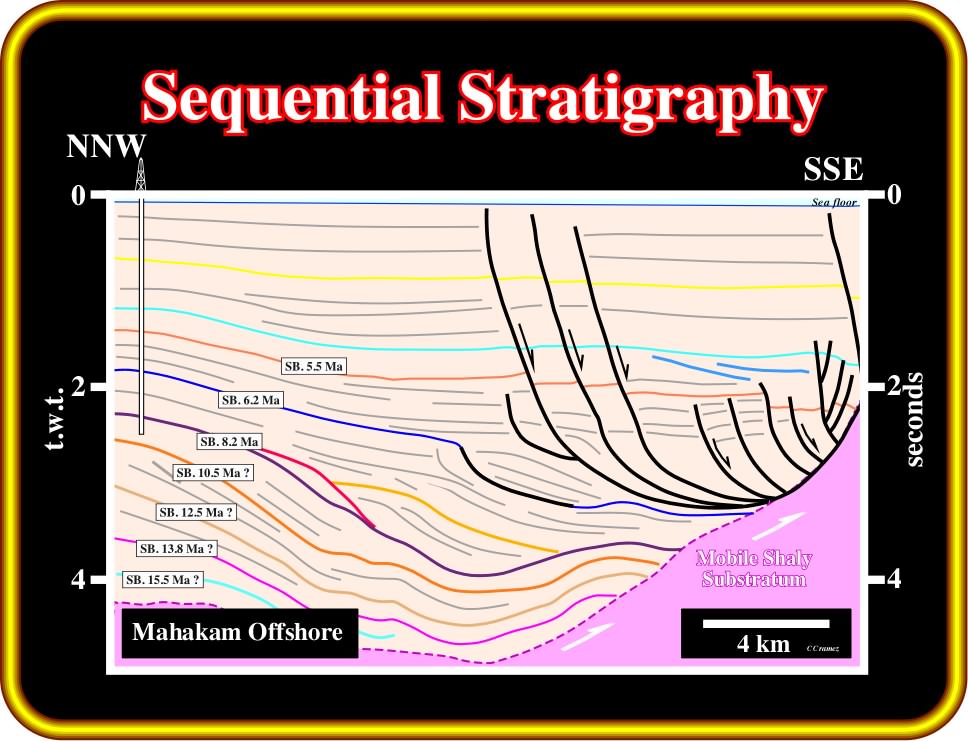
Plate 254- In this tentative interpretation of a seismic line of Mahakam offshore (Borneo offshore, Indonesia) and particularly in sequential stratigraphy, geoscientists must take into account that without an underlying hypothesis, theory, model, observations or experiments, picking seismic markers will not have any significance. The theory gives meaning to the observed, but, on the contrary, a theory without observations, for corroboration and testing, has no grip on reality. In other words, the better a geologist knows the global and regional geological setting of an area the easier are the geological tentative interpretations of the seismic lines shot in the area. In fact, on a seismic line, a geoscientist recognizes only what he knows. He has very little chance to find something that he is not looking for. On other hand, geoscientist known very well that is the work that creates interest and not the contrary.
Let's see few examples of sequential stratigraphy interpretations:

Plate 255 - The fundamental unit of sequential stratigraphy is the stratigraphic sequence-cycle. It is induced by a 1st order eustatic cycle and bounded by unconformities (erosional surfaces) or their correlative conformities. The age difference between the upper and lower unconformities should not be greater than 3-5 My. A sequence-cycle can be subdivided into systems tracts, which are defined by their positions within the sequence-cycle and by the stacking patterns of parasequence sets and parasequence cycles (see later) bounded by marine-flooding surfaces. This tentative geological interpretation of a North Sea seismic line is far from being correct. The age difference between the unconformities bounding the seismic intervals is much higher than 5 My. The seismic packages do not correspond to sequence cycles, but to stratigraphic cycles with a higher hierarchy (see later). They cannot be subdivided into systems tracts (as sequence cycles) so lithological predictions are hazardous. At such hierarchy, geologists can speak in transgressive and regressive episodes but not in transgressive and highstand systems tracts.

Plate 256- A lot of reflection terminations and subsequent seismic surfaces can be recognized on this tentative interpretation of a seismic line from the North Sea. The sequential interpretation seems quite easy. However, before starting the interpretation, the seismic interpreter (geophysicist or geologist) must not only know the global and regional geological settings of the area, but also decide at what hierarchical level the interpretation is possible. As you will see later, different stratigraphic cycles can be considered, depending on the order of the generative eustatic cycles. A glimpse at this tentative interpretation strongly suggests at least six well defined seismic packages bounded by onlap and truncation surfaces as illustrated on the next plate.
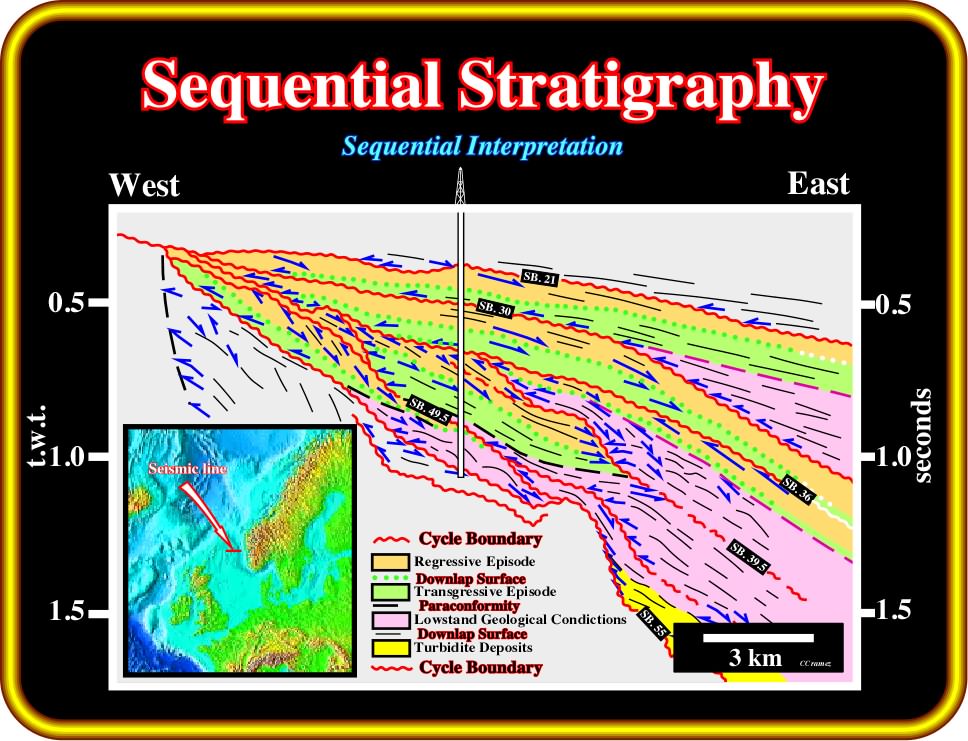
Plate 257- On this tentative interpretation of the previous North Sea line, the stratigraphic and paleontological results of well #A indicate that the more likely age of the unconformities, separating the different seismic packages are 21, 30 36, 39.5 (?), 49.5 and 55 millions years ago (Ma). Subsequently, the erosional surfaces associated with them were induced by eustatic cycles with time durations higher than 3-5 My. In other words, the seismic packages do not correspond to sequence cycles (see Plate 258). Within them, transgressive and regressive depositional episodes can be considered, but not depositional systems tracts. The violet intervals represent seismic packages deposited during lowstand geological conditions, i.e., periods of time during which the sea level is below the shelf break.
Sequential Stratigraphy Analysis
In a sequential stratigraphic interpretation of seismic data, the following steps are required:
A) Recognition of the unconformities using onlap and truncation reflection terminations;
B) Identification of stratigraphic cycles ;
For stratigraphic sequence cycles, identify:
- Type I unconformities ;
- Type II unconformities .;
C) Location of shelf breaks for each sequence cycle using sedimentary dip changes ;
D) Construction of coastal onlap and relative sea level curves ;
E) Recognition of Systems Tracts inside of each sequence cycle ;
F) Prediction of facies (lithology) for each depositional system composing the different systems tracts ;
G) Calibration of sequence cycles and systems tracts using exploration wells;
H) HC Potential of each sequence cycle using coastal onlap and sea level curves.

Plate 258 - A sequential interpretation at the level of sequence cycles, which, as said previously, are induced by eustatic cycles with a time duration between 0.5 - 3 My, or 0.5 and 5 My (according to certain geoscientists), is generally possible on the ground and electric logs, but seldom on seismic lines. Generally, on seismic lines, an interpretation at high hierarchy level (sequence cycle) is possible when the depositional rate is strong and seismic resolution high, as detailed on the next plates.
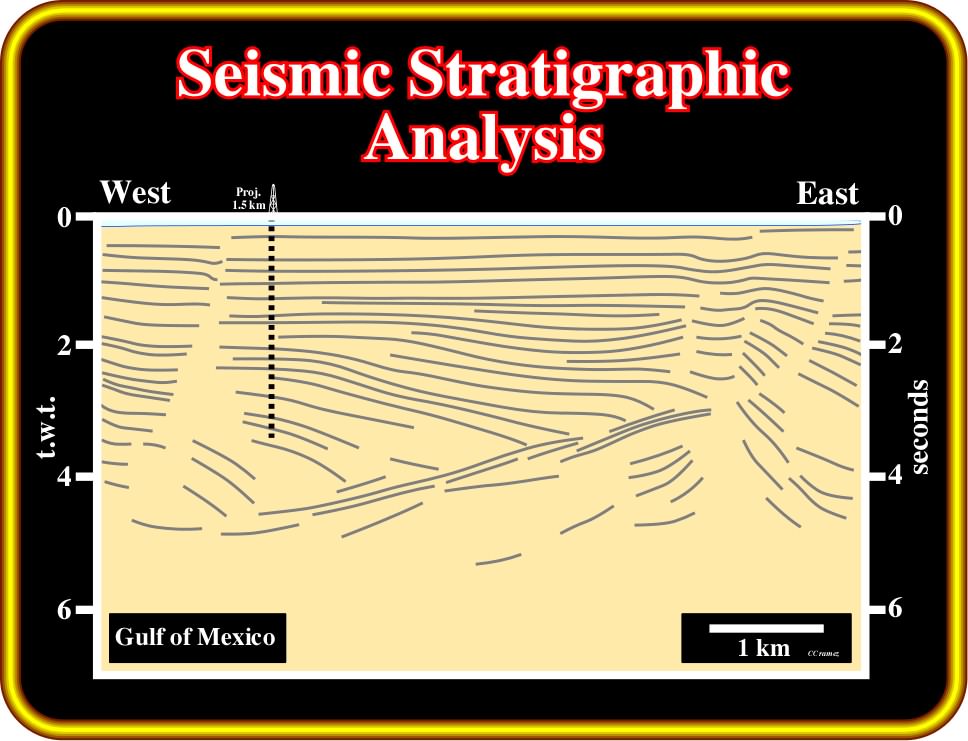
Plate 259 - On this first step of a tentative interpretation of a seismic line from the Gulf of Mexico, it is easy to understand that the depositional systems are mainly induced by a compensatory subsidence created by salt flowage. A tectonic disharmony, associated with the salt flowage, was developed at the top of the salt layer (probably autochthonous). It is recognized by tilted onlap reflection terminations, which are responsible for the thickening of the seismic packages toward the disharmony. The geometry of the seismic reflectors and the stratigraphic results of the well (projected ), suggest a rate of deposition large enough for the thickness of the sequence-cycles to be above the seismic resolution, as indicated on the interpretation depicted on the next figure.
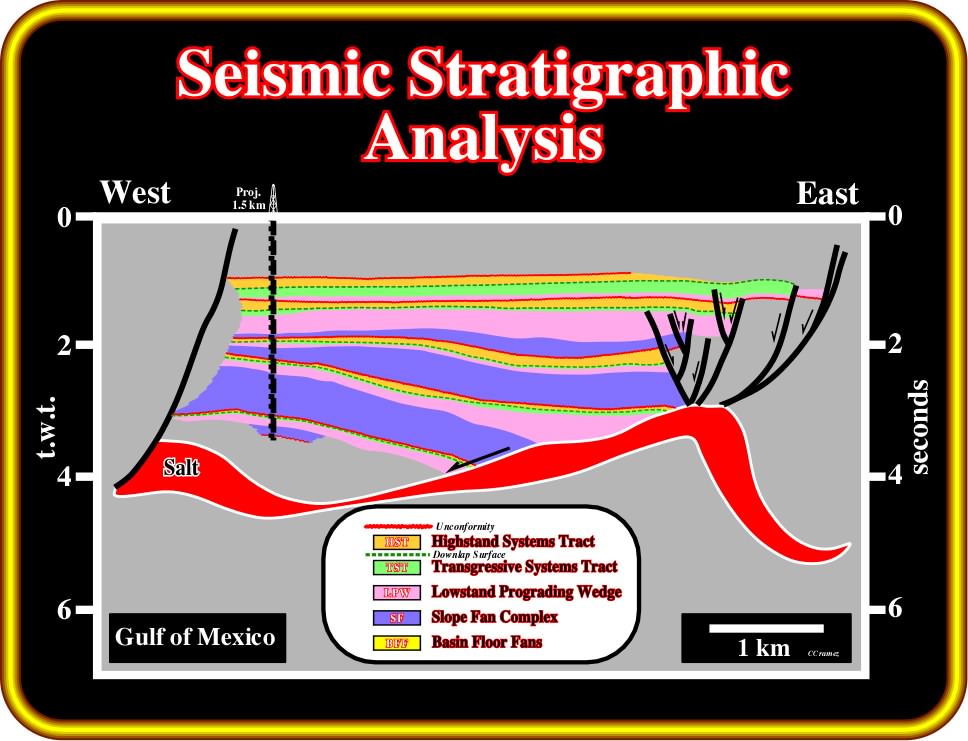
Plate 260 - On this provisional tentative interpretation of the same previous seismic line, the interpreter performed a sequential interpretation at the level of sequence-cycles. The stratigraphic results of the exploration well (Plate 273), drilled not too far off the profile, corroborated that the unconformities (in red) bound sequence-cycles. The upper seismic intervals are composed of systems tracts, that is to say, coeval and genetically related depositional systems, deposited in highstand geologic conditions (sea level above shelf break). In the lower intervals, systems tracts deposited in lowstand geologic conditions (sea level below shelf break, or when the basin does not platform) were also deposited. When these intervals were deposited the shelf break was located eastward of the line.
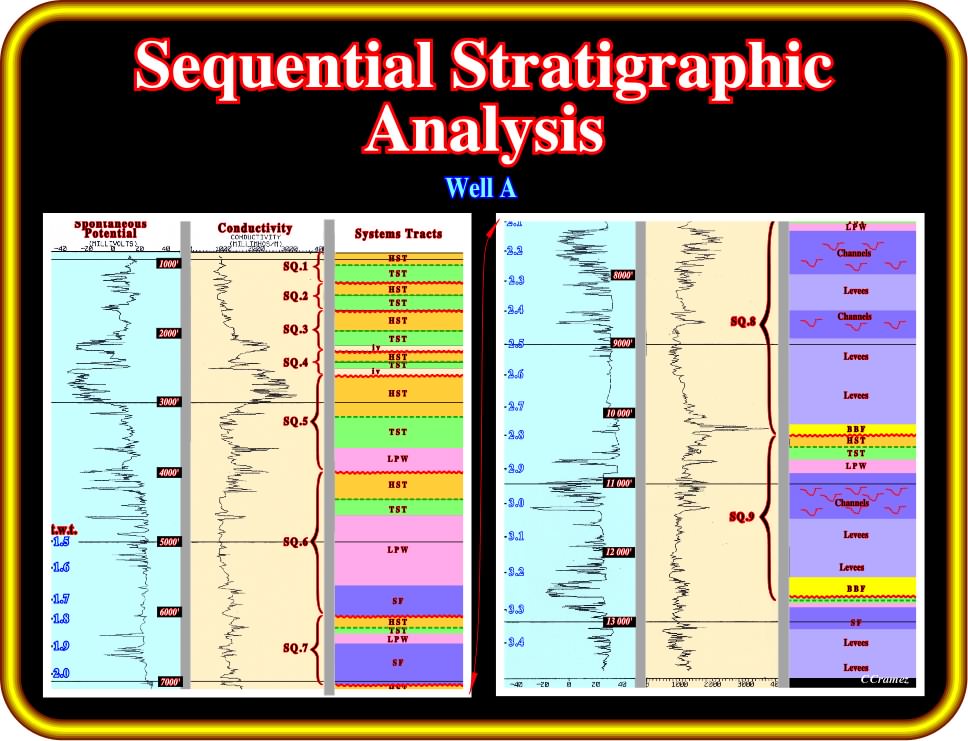
Plate 261 - As we will see later, each systems tract has a typical signature on electric logs. In addition, their stacking patterns, as well as those of parasequence sets and parasequences (high level stratigraphic cycles) bounded by marine-flooding surfaces, allow accurate sequential interpretation. As illustrated, the upper sequence is composed by highstand and transgressive systems tracts, while in the lower sequences all systems tracts, i.e., Highstand (HST), Transgressive (TST), Lowstand prograding wedge (LPW), Slope Fans (SF) and Basin Floor Fans (BFF) are present. Don’t be afraid with all these names. Actually, very soon, we are going to study all stratigraphic cycles and particular the sequence cycles, in which, systems tracts can be individualized.
Sequential versus Genetical Stratigraphy
Sequential and Genetical stratigraphy are complementary. Both are holistic and global. Their complementarity are particularly true in hydrocarbon exploration, where the predictions of the more likely potential source-rocks (generating petroleum subsystem) and reservoirs-rocks (entrapment petroleum subsystem) are of paramount importance.
On regional seismic lines, genetical interpretations, performed in terms of transgression/regression cycles are easier than sequential interpretations performed at high hierarchical levels: (i) Sequence cycles or (ii) Continental encroachment subcycles.
Sequential stratigraphy (Plate 262) is based on the identification of unconformities. Genetical stratigraphy (Plate 263) is mainly based on the recognition through time of:
(a) Major displacements of depositional coastal break (roughly the shoreline) ;
(b) Shelf break ;
(c) Downlap surfaces.
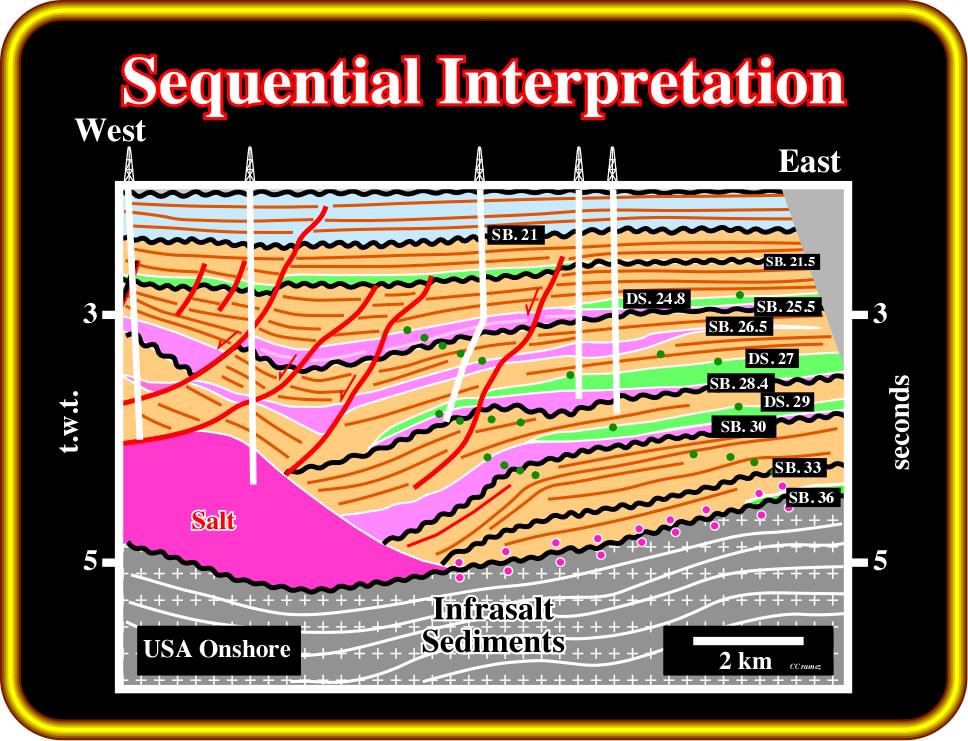
Plate 262- On this tentative interpretation ( Onshore USA), each unconformity (relative sea level fall) bounding sequence cycles is calibrated by well results. Their age is proposed in million years ago (Ma and not My, which means just million years). The large red dots underline a salt weld, while the green dots mark the successive positions of the shelf break. The stratigraphic intervals in purple correspond to an interval deposited during lowstand geological conditions.
During a transgression, the shelf break and depositional coastal break are individualized. The distance between them (platform or shelf environment) increases since the shoreline is progressively displaced landward. During a regression, the area of the shelf decreases progressively and it happens, often, that the depositional coastal break and shelf break become coincident. When this takes place, the sedimentary basin has no platform.
The interpretation of the tentative interpretation illustrated in Plate 274 is quite easy whether in stratigraphic cycles, bounded by unconformities (sequential stratigraphy) or in transgression/regression cycles (genetical stratigraphy). Onlap and toplap seismic surfaces are easily recognized. The identification and mapping of the unconformities bounding the different stratigraphic cycles can be made without difficulty. However, in normal seismic data (vertical exaggeration 2-5 times), sequential and genetic interpretations interpretations can only be correctly performed at low hierarchical levels (see later).

Plate 263 - This tentative interpretation of a seismic line from the North Sea illustrates a genetical interpretation. Major transgressions (in green) and regressions (in orange) are recognized and picked. The limits between transgressive and regressive intervals correspond to downlap seismic surfaces. The limits between regressive and transgressive intervals do not necessarily correspond always with an unconformity, i.e., with erosional surfaces. Sometimes they can correspond to conformities (e.g. the limit between the a lowstand prograding wedge systems tract, regression episode, and a transgressive systems tract).
In normal conditions, at the beginning of interpretation of seismic data, explorationists must know at what hierarchical level of interpretation can be performed. In order to achieve such a task, Duval (1993) proposed a hierarchy of the stratigraphic cycles based on unconformities (sequential stratigraphy). Such a hierarchy, based exclusively on the picking and dating of unconformities, will be proposed later.
Genetical interpretations are easy when performed in vertical exaggerated mathematical models, cross-sections, electric logs, or seismic lines shot through thick sedimentary depocenters (high rate of sedimentation). Offlap breaks (coastal or, and, shelfal) and major downlap surfaces (interfaces between backstepping and forestepping geometries) bounding the different genetic cycles are easily recognized:
1- A backstepping or a retrogradational geometry underlines a transgression; in other words. a landward displacement of the coastal deposits;
2- A forestepping or a progradational geometry emphasizes a regression, that is to say, a seaward displacement of the coastal deposits.
Generally, the to and fro movement of coastal deposits are not driven by the worldwide sea-level regime and its fluctuations induced by absolute changes in the quantity of Earth’s seawater. The displacements of shorelines are, in fact, mainly related with relative sea level changes resulting from the interactions between:
A) Sea Level Change ;
B) Subsidence or Uplift (Tectonics) ;
C) Terrigeneous Influx.
Coastal deposits (roughly near the shoreline) can be associated either with the coastal break or shelf break. During transgressive episodes both breaks are associated with a progressive landward displacement of the coastal break which creates of a platform (shelf) environment.
In petroleum exploration, sequential interpretations are mainly used in to predict potential reservoir-rock, which onlap against the unconformities, while genetical interpretations are mainly used to predict major potential marine source-rocks, which are associated with downlap surfaces.
Hierarchical Level of Interpretation
In spite of the fact that the Hierarchy Theory has been embraced by a large majority of geologists, it will be useful here to describe several of its aspects advanced mainly by Huxley (1925) and Koester (1967). We will start with the parable of the Two Watchmakers taken from Koestler‘s book “The Ghost in the Machine”. It illustrates the main principles and advantages of the hierarchy theory.
“There were once two Swiss watchmakers named Bios and Mekhos, who made very fine and expensive watches. Although their watches were equal in demand, Bios prospered, while Mehkos just struggled along; in the end he had to close his shop and take a job as mechanic with Bios. The people in the town argued for a long time over the reasons for this development and each had a different theory to offer, until the true explanation leaked out and proved to be both simple and surprising. The watches they made consisted of about one thousand parts each, but the two rivals had used different methods to put them together. Mekhos had assembled his watches bit by bit rather like making a mosaic floor out of small colored stones. Thus, each time when he was disturbed in his work and had to put down a partly assembled watch, it fell to pieces and he had to start again from scratch. Bios, on the other hand, had designed a method of making watches by constructing, for a start, sub-assemblies of about ten components, each of which held together as an independent unit. Ten of these sub-assemblies could then be fitted together into a sub-system of a higher order; and then of these sub-systems constitute the whole watch. This method proved to have two immense advantages. In the first place, each time there was an interruption or a disturbances, and Bios had to put down, or even drop, the watch he was working on, it did not decompose into its elementary bits; instead of starting all over again, he merely had to reassemble that particular sub-assembly on which he was working at the time; so that at worst (if the disturbance came when he had nearly finished the sub-assembly in hand) he had to repeat nine assembling operations, then Mekhos will take four thousand times longer to assemble a watch than Bios. Instead of a single day, it will take him eleven years. And, if for mechanical bits we substitute amino acids, protein molecules, organelles, and so on, the ratio between the time-scales becomes astronomical; some calculations indicate that the whole lifetime of the earth would be insufficient for producing even an amoeba - unless he becomes converted to Bios‘ method and proceeds hierarchically, from simple sub-assemblies to more complex ones. A second advantage of Bios‘ method is of course that the finished product will be incomparably more resistant to damage, and much easier to maintain, regulate, and repair, than Mekhos‘s unstable mosaic atomic bits” The universal characteristics of hierarchies are the relativity and, indeed, the ambiguity, of the terms part and whole when applied to any of sub-assemblies”.
A part as we generally use the word... wrote Abraham... means something fragmentary and incomplete, which by itself would have no legitimate existence. On the other hand, a whole is considered as something complete in itself, which needs no further explanation. But wholes and parts, in this absolute sense, just do not exist anywhere, either in the domain of living organisms, geological structures or social organizations. What we find are intermediary structures on a series of levels in an ascending order of complexity: sub-wholes, which display, according to the way you look at them, some of the characteristics commonly attributed to parts”
The relativity of hierarchies, known as Janus dualism, it is an important feature in a sequential interpretation approach:
- Geoscientists progress from the general to the particular ;
- Geoscientists cannot study geological events in isolation ;
- Geological structures, as well as biological structures, are multi-leveled ;
- Each of them forms a whole with respect to its parts, while, at the same time, they are a part of a larger whole ;
- Geological structures, and particularly stratigraphic intervals, have a hierarchical nature, which implies different levels of stratigraphic interpretations.
Taking into account all these conjectures, on the tentative interpretation illustrated in Plate 262:
(i) The ages of unconformities SB. 25.5 Ma and SB. 28.4 Ma are based on micropaleontology results of the exploratory wells drilled in the area ;
(ii) The ages proposed for the unconformities older than SB. 28.4 Ma are speculative (they are not calibrated) ;
(iii) The wells located on the left part of the seismic profile reached the allochthonous salt nappe, but they did not recognize the sediments overlying the salt weld, which, conventionally, is underlined by double red dots, one can say the proposed interpretation is cyclic and multi-leveled.
We tried to identify stratigraphic cycles bounded by unconformities (erosional surfaces associated with significant relative sea level falls). The cycles identified are sequence cycles since they are associated with eustatic cycles of time duration less than 3 My (the difference of age of two consecutive unconformities is always lower than 3-5 My). Similar detailed interpretations (high hierarchical level) cannot be done on seismic lines from basins with moderate or low rates of sedimentation (see later).
The tentative interpretation on the North Sea regional seismic line, illustrated in Plate 263, allows only systemic or genetic geological interpretations at a low hierarchical level, in which major transgression/regression cycles can be readily identified. Generally, genetical interpretations are easier than sequential interpretations. Indeed, downlap seismic surfaces are sharper and more continuous than unconformities.
The proposed tentative interpretation (Plate 263) suggests:
(i) The time interval between the successive unconformities, or downlap surfaces, is always higher than 3.0 My ;
(ii) The limits between transgressive and regressive episodes are downlap surfaces. They underline and emphasize non-depositional hiatus and starved geological conditions ;
(iii) Downlap surfaces are associated with condensed stratigraphic sections, in which faunistic peaks are paramount, that is to say, they are better and easier dated than unconformities ;
(iv) The limits between regressive and transgressive episodes are flooding surfaces and unconformities ;
(v) In proximal parts of sedimentary basins, particularly, landward of lowstand deposits, the interface between regressive and transgressive episodes belong to different stratigraphic cycles. The interfaces are mainly unconformities ;
(vi) When transgressive and regressive episodes belong to the same stratigraphic cycle, the interface between them corresponds to a flooding surface ;
(vii) In distal parts of a basin, it is possible to find successive regressive intervals pertaining to different stratigraphic cycles separated by unconformities. In other words: basinward and downward shifts of coastal onlap (unconformities) do not necessarily imply a change in the geometry of the deposits. Forestepping deposits remain predominant.